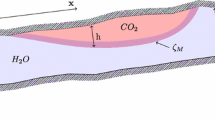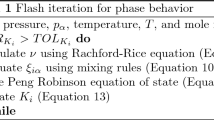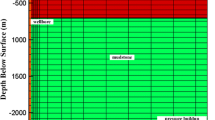Abstract
We have extended an existing streamline simulator (Batycky et al., SPE Reserv Eng 12(4):246–254, 1997) that considered two phases (aqueous and hydrocarbon) and two components (water and oil) to handle three-phase (aqueous, hydrocarbon, and solid), four-component (water, oil, CO2, and salt) transport applied to CO2 injection. We solved CO2 transport equations in the hydrocarbon and aqueous phases along streamlines and in the direction of gravity. To capture the physics of CO2 transport, in the hydrocarbon phase, we used the Todd–Longstaff model (Todd and Longstaff, J Pet Technol 24(7):874–882, 1972) to represent subgrid-block viscous fingering. We implemented a thermodynamic model of mutual dissolution between CO2 and water with salt precipitation (Spycher et al., Geochim Cosmochim Acta 67(16):3015–3031, 2003; Spycher and Pruess, Geochim Cosmochim Acta 69(13):3309–3320, 2005). The resultant changes in porosity and permeability due to chemical reaction and salt precipitation were also considered. We accounted for two cycles of relative permeability hysteresis (primary and secondary drainage and imbibition) by applying two different trapping models: Land (SPE J 8:149–156, 1968) and Spiteri et al. (SPE J 13(3):277–288, 2008). Relative permeability changes and variations in the trapped nonwetting phase saturations due to hysteresis were updated on a block-by-block basis. We verified our simulator by comparing one-dimensional simulation results with analytical solutions. We then performed simulations on three-dimensional reservoir models. We first simulated dry CO2 injection in an aquifer to investigate the effect of salt precipitation. After 2 years of CO2 injection, the permeability reduced by approximately 20%. We then used the simulator to design CO2 injection strategies in aquifers to maximize CO2 storage and in oil reservoirs to optimize both CO2 storage and oil recovery. Simulations were conducted on a North Sea reservoir description. We propose to inject CO2 and water simultaneously, followed by chase brine injection, which could render the majority of CO2 injected immobile while giving a much higher storage efficiency than injecting CO2 alone.
Similar content being viewed by others
References
Batycky, R.P., Blunt, M.J., Thiele, M.R.: A 3D field-scale streamline-based reservoir simulator. SPE Reserv. Eng. 12(4), 246–254 (1997)
Beraldo, V.T., Blunt, M.J., Schiozer, D.J.: Compressible streamline-based simulation with changes in oil composition. In: Proceedings of the SPE Annual Technical Conference and Exhibition SPE, vol 115983, Denver, 21–24 September 2008
Blunt, J.M., Barker, J.W, Rubin, B., Mansfield, M., Culverwell, I.D., Christie, M.A.: Predictive theory for viscous fingering in compositional displacement. SPE Reserv. Eng. 9(1), 73–80 (1994)
Blunt, J.M.: An empirical model for three-phase relative permeability. SPE J. 5, 435–445 (2000)
Blunt, J.M., Liu, K., Thiele. M.R.: A generalized streamline method to predict reservoir flow. Pet. Geosci. 2, 259–269 (1996)
Bratvedt, F., Gimse, T., Tegnander, C.: Streamline computations for porous media flow including gravity. Transp. Porous Media 25, 63–78 (1996)
Carlson, F.M.: Simulation of relative permeability hysteresis to the nonwetting phase. In: Proceedings of the SPE Annual Technical Conference and Exhibition. SPE, vol. 10157, San Antonio, 5–7 October 1981
Parliamentary Office of Science and Technology: Carbon Capture and Storage. Number: 238, post note March 2005
Cheng, H., Oyerinde, D., Datta-Gupta, A., Milliken, W.: Compressible streamlines and three-phase history matching. SPE J. 12(4), 475–485 (2007)
Christie, M.A., Blunt, M.J.: Tenth SPE comparative solution project: a comparison of upscaling techniques. SPE Reserv. Evalu. Eng. 4(4), 308–317 (2001)
Crane, M.J., Blunt, M.J.: Streamline-based simulation of solute transport. Water Resour. Res. 35(10), 3061–3078 (1999)
Datta-Gupta, A., King, M.J.: A semianalytical approach to tracer flow modeling in heterogeous permeable media. Adv. Water Resour. 18, 9–29 (1995)
Di Donato, G., Blunt, M.J.: Streamline-based dual-porosity simulation of reactive transport and flow in fractured reservoirs. Water Resour. Res. 40, W04203 (2004). doi:10.1029/2003WR002772
Emanuel, A.S., Milliken, W.J.: Matching finite difference models with 3D streamlines. In: Proceeding of the SPE Annual Technical Conference and Exhibition. SPE, vol. 49000, New Orleans, 27–30 September 1998
Ennis-King, J., Paterson, L.: Engineering aspects of geological sequestration of carbon dioxide. In: Proceedings of the Asia Pacific Oil and Gas Conference and Exhibition. SPE, vol. 77809, Melbourne, 8–10 October 2002
Förster, A., Norden, B., Zinck-Jøgensen, K., Frykman, P., Kulenkampff, J., Spangenberg, E., Erzinger, J., Zimmer, M., Kopp, J., Borm, G., Juhlin, C., Cosma, C., Hurter, S.: Baseline characterization of the CO2SINK geological storage site at Ketzin Germany. Environ. Geosci. 13(3), 145–161 (2006)
García, J.E.: Density of Aqueous Solutions of CO2. Lawrence Berkeley National Laboratory Report LBNL-49023, Berkeley, CA (2001)
Ghomian, Y., Pope, G.A., Sepehmoori, K.: Hysteresis and field-scale optimization of WAG injection for coupled CO2-EOR and sequestration. In: Proceedings of the SPE/DOE Improved Oil Recovery Symposium. SPE, vol. 110639, Tulsa, 19–23 April 2008
Gross, H., Thiele, M.R., Alexa, M.J., Caers, J.K., Kovscek, A.R.: Streamline-based history matching using geostatistical constraints: application to a giant, mature carbonate reservoir. In: Proceeding of the SPE Annual Technical Conference and Exhibition. SPE, vol. 90069, Houston, 26–29 September 2004
Climate Change 2001: UN Intergovernmental Panel on Climate Change (IPCC) Third Assessment Report (2001)
Jessen, K., Kovscek, A.R., Orr, F.M.: Increasing CO2 storage in oil recovery. Energy Convers. Manag. 46(2), 293–311 (2005)
Juanes, R., Spiteri, E.J., Orr, Jr. F.M., Blunt, M.J.: Impact of relative permeability hysteresis on geological CO2 storage. Water Resour. Res. 42, W12418 (2006)
Kovscek, A.R., Cakici, M.D.: Geologic storage of carbon dioxide and enhavced oil recovery. II. Cooptimization of storage and recovery. Energy Convers. Manag. 46, 1941–1956 (2005)
Kumar, A., Ozah, R., Noh, M. Pope, G.A., Bryant, S., Sepehrnoori, K., Lake, L.W.: Reservoir simulation of CO2 storage in deep saline aquifers. SPE J. 10(3), 336–348 (2005)
Lake, L.W.: Enhanced Oil Recovery. Prentice-Hall, Englewood Cliffs (1989)
Land, C.S.: Calculation of imbibition relative permeability for two- and three-phase flow from rock properties. SPE J. 8, 149–156 (1968)
Muskat, M.: Flow of Homogeneous Fluids. International Human Resources Developement Corporation, Boston (1937)
Oak, M.J.: Three-phase relative permeability of Water-wet Berea. In: Proceedings of the SPE/DOE Seventh Symposium on Enhanced Oil Recovery. SPE, vol. 20183, Tulsa, 22–25 April 1990
Obi, E.I., Blunt, M.J.: Streamline-based simulation of carbon dioxide storage in a north sea aquifer. Water Resour. Res. 42, W03414 (2006)
Osako, I., Datta-Gupta, A.: A compositional streamline formulation with compressibility effects. In: Proceedings of the SPE Reservoir Simulation Symposium. SPE, vol. 106148, Houston, 26–28 February 2007
Pollock, D.W.: Semi-analytical computation of pathlines for finite-difference models. Groundwater 26(b), 743–750 (1998)
Potter, R.W., Babcock R.S., Brown D.L.: A new method for determing the solubility of salts in aqueous solutions at elevated temperatures. J. Res. U.S. Geol. Surv. 5(3), 389–395 (1077)
Prausnitz, J.M., Lichtenthaller, R.N., De Azedevo, E.G.: Molecular Thermodynamics of Fluid Phase Equilibria. Prentice Hall, New York (1986)
Qi, R., LaForce, T.C., Blunt, M.J.: Design of carbon dioxide storage in aquifers. Int. J. Greenh. Gas Control 3(2), 195–205 (2009)
Qi, R., LaForce, T.C., Blunt, M.J.: Design of carbon dioxide storage in oilfields. In: Proceedings of the SPE Annual Technical Conference and Exhibition. SPE, vol. 115663, Denver, 21–24 September 2008
Redlich, O., Kwong, J.N.S.: On the thermodynamics of solutions. V. An equation of state, fugacities of gaseous solutions. Chem. Rev. 44, 233–244 (1949)
Spiteri, E., Juanes, R., Blunt, M.J., Orr, Jr. F.M.: A new model of trapping and relative permeability hysteresis for all wettability characteristics. SPE J. 13(3), 277–288 (2008)
Spycher, N., Pruess, K., Ennis-King, J.: CO2-H2O mixtures in the geological sequestration of CO2. I. Assessment and calculation of mutual solubilities from 12 to 100 °C and up to 600 bar. Geochim. Cosmochim. Acta 67(16), 3015–3031 (2003)
Spycher N., Pruess, K.: CO2-H2O mixtures in the geological sequestration of CO2. II. Partitioning in chloride brines at 12 to 100 °C and up to 600 bar. Geochim. Cosmochim. Acta 69(13), 3309–3320 (2005)
Stueben, K.: Algebraic multigrid (AMG): experience and comparisons. In: Proceedings of the International Multigrid Conference. Applied Mathematics and Computation, vol. 13, pp. 419–452 (1983)
Thiele, M.R.: Streamline simulation. In: Proceeding of the 7th International Forum on Reservoir Simulation, Baden-Baden, 23–27 June 2003
Todd, M., Longstaff, W.: The development, testing and application of a numerical simulator for predicting miscible flood performance. J. Pet. Technol. 24(7), 874–882 (1972)
Valvatne, P.H., Blunt, M.J.: Predictive pore-scale modelling of two-phase flow in mixed wet media. Water Resour. Res. 40, W07406 (2004). doi:10.1029/2003WR002627
Wellman, T., Grigg, R., McPherson, B., Svec, R., Lichtner, P.: Evaluation of CO2-bring-reservoir rock interaction with laboratory flow tests and reactive transport modeling. In: Proceedings of the SPE Symposium on Oilfield Chemistry. SPE, vol. 80228, Houston, 5–7 February 2003
Author information
Authors and Affiliations
Corresponding author
Rights and permissions
About this article
Cite this article
Qi, R., LaForce, T.C. & Blunt, M.J. A three-phase four-component streamline-based simulator to study carbon dioxide storage. Comput Geosci 13, 493–509 (2009). https://doi.org/10.1007/s10596-009-9139-9
Received:
Accepted:
Published:
Issue Date:
DOI: https://doi.org/10.1007/s10596-009-9139-9




